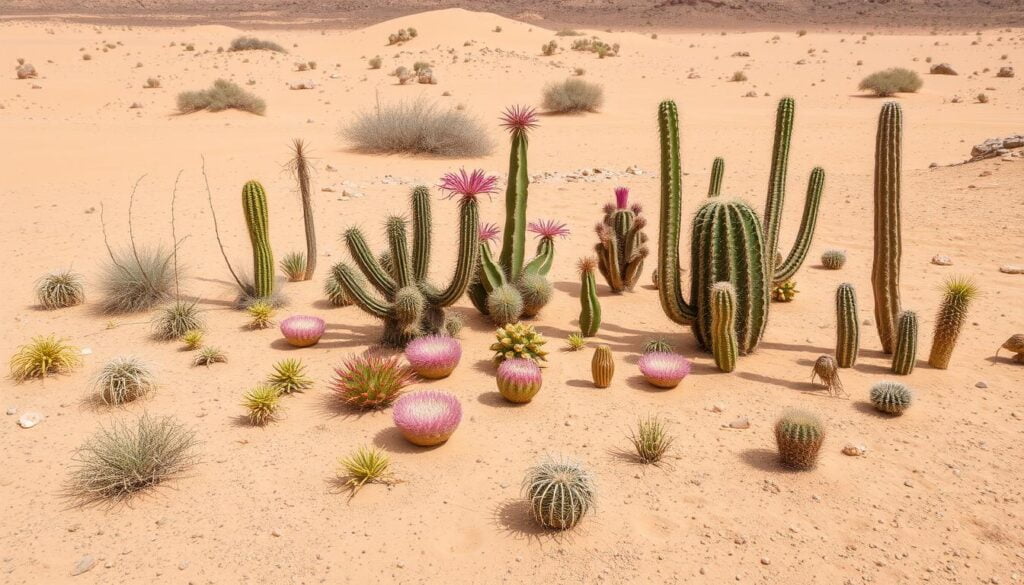The desert is tough and unforgiving, yet it’s full of plants that have learned to live there. The Saguaro cactus can grow up to 52 feet tall. The Joshua tree can reach 50 feet. These plants show how nature can survive and even thrive in extreme heat and dryness.
In the American Southwest’s deserts, we’ll look at 20 amazing plant species. They’ve developed special ways to survive in tough conditions. By learning about these plants, we can see how diverse and resilient nature is.
Key Takeaways
- The desert is home to a diverse array of plants that have adapted to thrive in arid conditions.
- From the towering Saguaro cactus to the resilient Joshua tree, these plants showcase nature’s incredible ability to survive in harsh environments.
- Across the Sonoran, Mojave, and Chihuahuan deserts, we’ll explore 20 unique desert plant species and their remarkable survival strategies.
- Understanding the adaptations of these plants can help us appreciate the diversity and resilience of our natural world.
- These desert plants have evolved characteristics like succulence, drought tolerance, and drought avoidance to conquer the harshest of environments.
Resilient Desert Plants: Sculptured by Sun and Scarcity
The desert is tough and unforgiving, but some plants have learned to live in it. These plants are great for yards or gardens in desert areas or hot places. They include the tall saguaro cactus and the plump-leaved succulents. These plants have special ways to survive in dry places.
Mastering the Desert’s Extremes
Cacti and succulents are key to surviving the desert’s harsh climate. They store water in their thick leaves, stems, and roots. This lets them go without rain for a long time. Their leaves are small and covered in wax to save water, making them perfect for the desert.
| Plant | Height | Width |
|---|---|---|
| Creosote Bush | 6 to 12 feet | N/A |
| Giant Saguaro Cactus | Up to 50 feet | Up to 25 feet |
| Ocotillo | Up to 20 feet | 5 to 10 feet |
| Spiral Aloe | 1 to 2 feet | 1 to 2 feet |
| Palmer’s Penstemon | 3.5 to 7 feet | N/A |
| Joshua Tree | 15 to 30 feet | 15 to 30 feet |
These desert plants have special ways to live in the desert’s tough conditions. They store water and adapt to dryness, showing how amazing nature can be. They are shaped by the desert’s sun and lack of water.
Characteristics of Desert Plants
Desert plants have amazing traits that help them live in tough places. They are good at storing water and avoiding drought. These skills let them make the most of every drop of water and survive in dry areas.
Succulence: Nature’s Water Reservoirs
Succulence is a key feature of many desert plants. Their thick leaves and stems hold water, saving it for dry times. This way, succulents can live and even thrive in very dry places.
Drought Tolerance: Enduring the Arid Onslaught
Desert plants have special ways to last through dry spells. They have deep roots, waxy layers, and small leaves to save water. This helps them survive even when everything else dries up.
Drought Avoidance: The Art of Dormancy
Some desert plants go dormant during droughts. They stop growing and using energy to save their resources. When it rains again, they quickly start growing and acting normally. This way of avoiding drought is a natural wonder.
| Adaptation | Description | Example Species |
|---|---|---|
| Succulence | Fleshy leaves and stems that store water | Prickly pear cactus, agave, aloe vera |
| Drought Tolerance | Extensive root systems, waxy coatings, reduced leaf area | Creosote bush, Joshua tree, organ pipe cactus |
| Drought Avoidance | Entering dormancy during dry periods | Many annual desert plants, some desert shrubs |

“Every feature of desert plants serves a purpose, designed by nature for extreme endurance.”
Succulence: Nature’s Water Reservoirs
Succulence is a fascinating way that some desert plants survive in tough environments. Plants like the Anacacho Orchid Tree, Arizona Poppy, and Old Man Cactus store water in their leaves and stems. This helps them live in dry places.
These plants have special tissues called parenchyma for storing water. Leaf succulents have thick leaves full of water-storing parenchyma. Stem succulents store water in their stems instead of leaves, helping them survive without losing much water.
Some plants, called caudiciform plants, have a swollen trunk or roots that act as a water and nutrient reserve. This lets them last through long droughts. It shows how nature has found clever ways to survive in dry places.
Succulence and the CAM process help these plants live in places with little water. They store water in special tissues and have efficient photosynthesis. This makes them great at saving water, even in very dry deserts.
| Succulent Adaptation | Key Characteristics |
|---|---|
| Leaf Succulence | Thick, fleshy leaves with water-storing parenchyma tissue |
| Stem Succulence | Shifted water preservation to stems, allowing for diminished or absent leaves |
| Caudiciform Plants | Swollen trunk or root system (caudex) that stores water and nutrients |
These amazing adaptations let succulents live in dry places. They also show us how plants have evolved to save every drop of water. By learning about how they store water, we can see how resilient and clever these desert plants are.
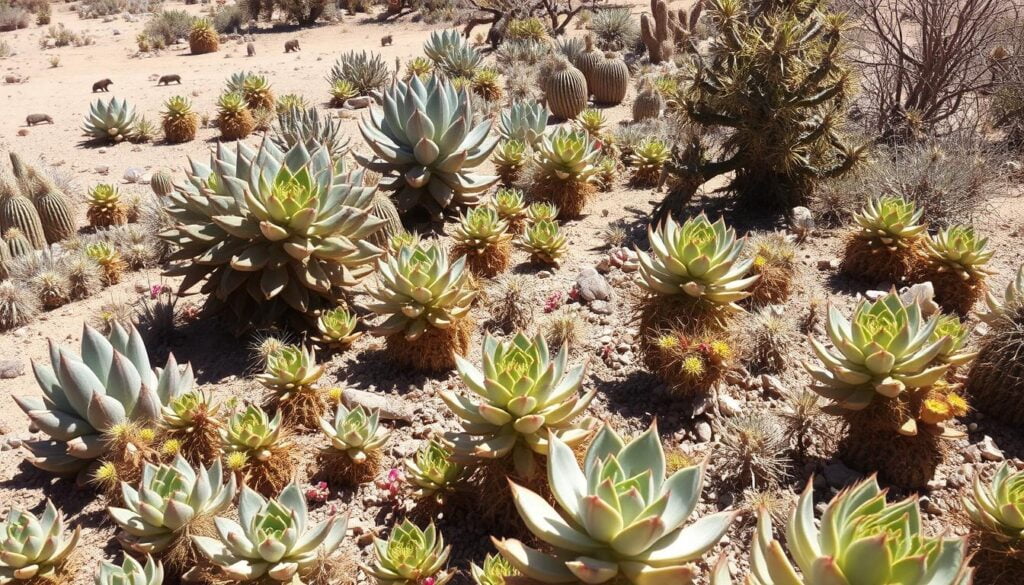
Drought Tolerance: Enduring the Arid Onslaught
Desert plants have amazing ways to survive the harsh desert conditions. Cacti and succulents use special methods to save every drop of water. Their thick coatings and small leaves help them lose less water, letting them live where others can’t.
But it’s not just about the leaves. These plants have deep roots that search for water deep in the earth. These roots can go far beyond what you see, finding water that other plants can’t reach. This helps them survive during dry times.
“Alvelal members manage more than 15,000 hectares (37,000 acres) of farmland using regenerative agriculture techniques and aim to expand further.”
Thanks to their special traits – like waxy coatings, small leaves, and deep roots – cacti and succulents can live in places others can’t. Their ability to conserve water shows how nature has adapted these plants to survive the desert’s dryness.
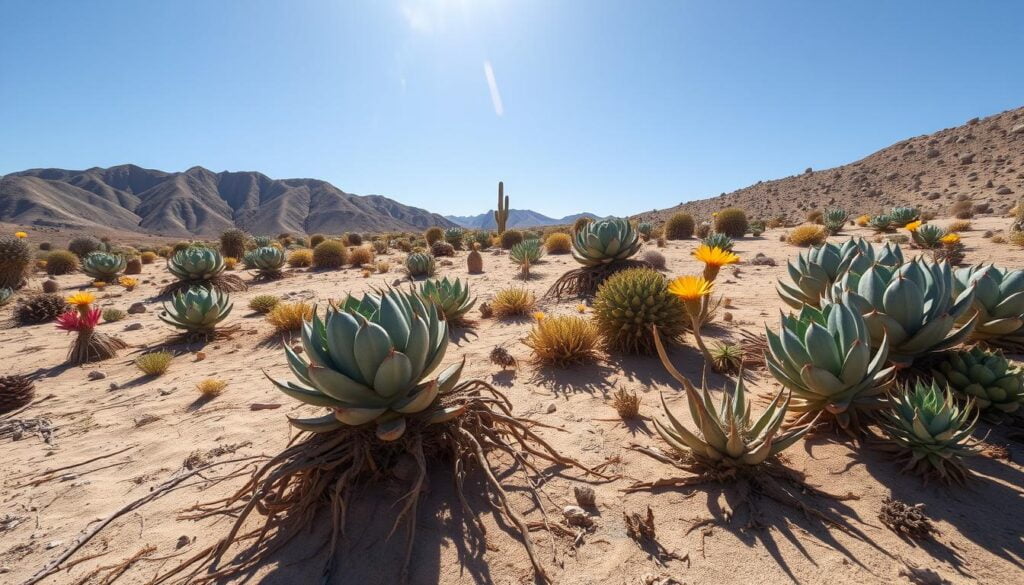
Drought Avoidance: The Art of Dormancy
Some desert plants can survive without much water, but others use dormancy to get through dry times. Plants like succulents and cacti slow down their growth when it’s dry to save water. This helps them survive in places with little rain.
Species like the Mexican Lime Cactus and Jumping Cholla use dormancy to stay alive. They stop growing and rest, using every drop of water wisely. This way, they can make it through long dry spells.
The way they do this is quite interesting. Summer-dormant cool-season perennial grasses have a Summer Dormancy Index (SDI) that shows how dormant they are. This index ranges from 0 to 10, with 2 to 6 meaning they’re not fully active or dormant.
Studies show that certain genes help plants survive dry times. These genes, like CONSTANS and TERMINAL FLOWER, play a big role in dormancy.
Surviving drought is all about finding the right balance. Some plants keep their water levels up to avoid drying out. Others can handle being dry for a long time thanks to their strong metabolism. Knowing how plants survive dry spells is key for farming in dry areas, where it can affect people’s lives.
| Plant Type | Dormancy Strategy | Drought Adaptation |
|---|---|---|
| Summer-dormant grasses | Summer dormancy (SDI 2-6) | Avoid summer drought and heat |
| Resurrection plants | Desiccation-tolerant dormancy | Recover from extreme dehydration |
| Cacti and succulents | Growth regulation based on moisture | Conserve water during dry seasons |
The desert is tough, and its plants have learned to save water and survive. From dormant plants that avoid drought to those that can endure dryness, these plants amaze us all.

Four Types of Desert Plants
In the vast desert, you’ll find many types of plants. These include succulents, cacti, shrubs and grasses, and wildflowers. Each type has special ways to survive in the hot, dry desert.
Succulents: Built-in Water Reservoirs
Succulents have thick leaves or stems that can hold water. This lets them survive the desert’s heat and dry spells.
Cacti: Prickly Survivors
Cacti are known for their spines instead of leaves. These spines help protect them from animals and save water in the desert.
Shrubs and Grasses: Rooted in Resilience
Desert shrubs and grasses cover the ground with green. They have deep roots to find water deep in the earth. This helps them survive the desert’s dryness.
Wildflowers: Bursts of Color in the Desert
Wildflowers add color to the desert with their brief blooms. They show how nature can thrive even in tough conditions.
The desert is full of different plants, each with its own way to survive. From the tall saguaros to the tiny wildflowers, they all show how life can flourish in the desert.
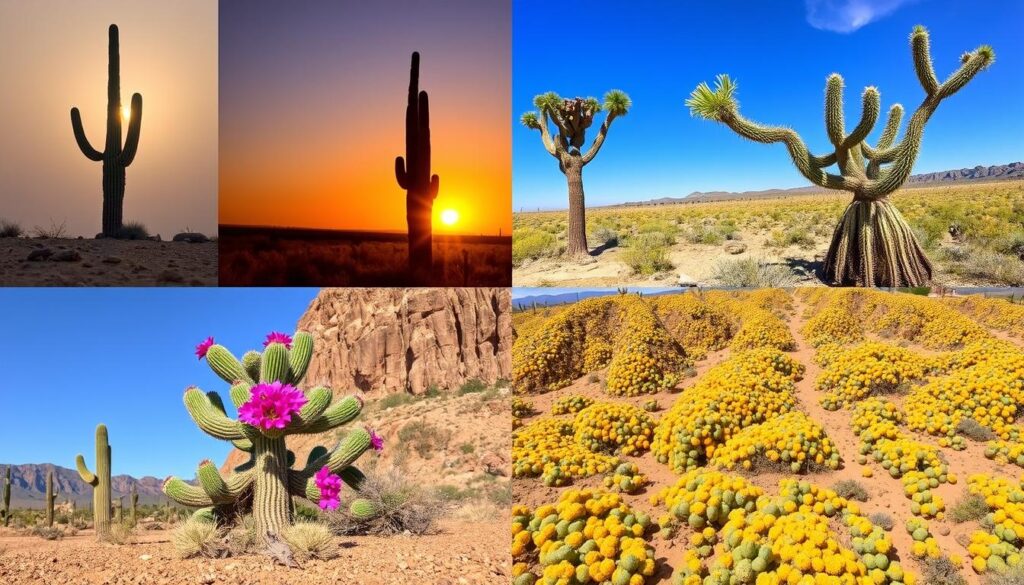
Succulents: Champions of Water Storage
In the desert, succulents are the top plants for storing water. They have a special way to keep water in their leaves, stems, and roots. This lets them live in very dry places where water is scarce.
The Kalanchoe, or Flapjacks, are a great example. They have thick leaves that hold water, unlike other plants that dry out quickly. Succulents like Kalanchoe stay healthy and bright, using their stored water to survive through dry spells and high heat.
- Succulents actively convert CO2 into oxygen, serving as natural air purifiers in indoor spaces.
- Aloe vera is a popular succulent that can remove harmful compounds like formaldehyde and xylene from the air.
- Echeveria, a stunning succulent, is a prime example of a xeriscape-friendly plant due to its minimal water requirements.
Succulents are not just pretty; they’re also very tough. They can survive with little water, teaching us about living sustainably. By adding succulents to our gardens or homes, we enjoy their beauty and help the planet.
“Succulents are the champions of desert plant survival. Their capacity to store water sets them apart and ensures their resilience under full sun.”
Succulents like aloe vera help with skin problems and gut issues, showing their many uses. As we learn more about these tough plants, we see how they can help us live well in dry places.
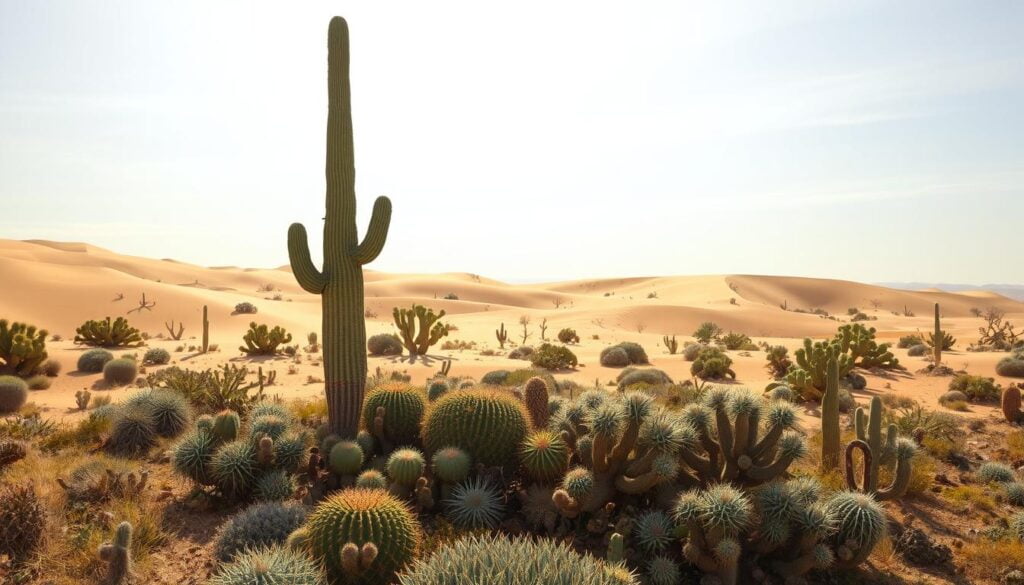
Cacti: Prickly Survivalists of the Plant Kingdom
Cacti are the ultimate survivors in the plant world. They live in the toughest desert climates, facing extreme heat and little water. They store moisture in their stems, which helps them survive.
Cacti vary in size and shape, from tall columns to round ones. They surprise us with bright flowers in red, yellow, and pink. These flowers brighten the desert and draw tourists. Native cultures use cacti for food, medicine, and building materials.
The cactus family shows how well they adapt to harsh deserts. They store water and have special ways to survive. These plants are symbols of the desert’s beauty and strength.
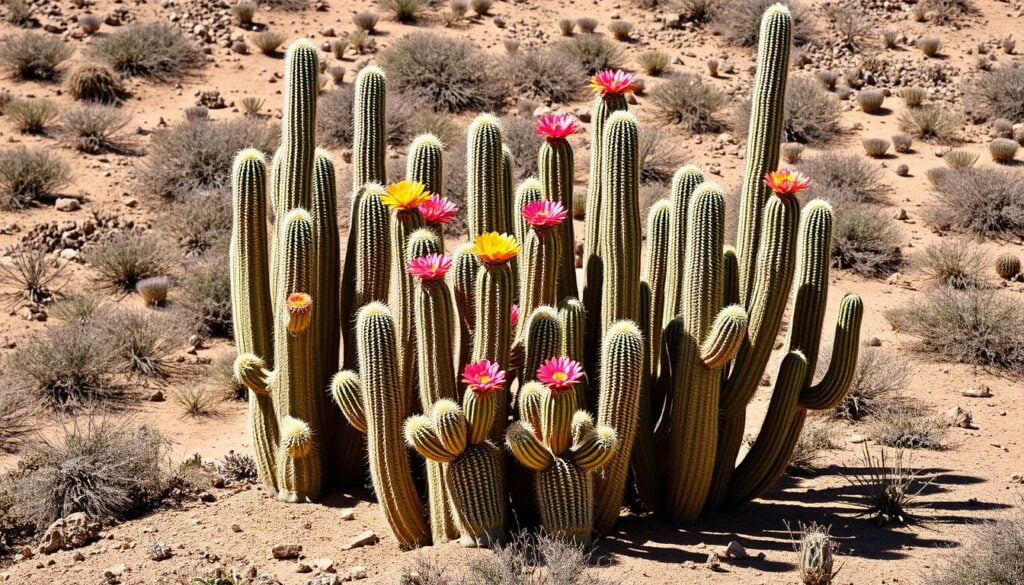
“Cacti are the ultimate survivors in the plant kingdom, thriving where others wither.”
Cacti stand out with their unique shapes and colorful flowers. They capture our hearts and imaginations. By learning about these plants, we understand how life can thrive in tough places.
Shrubs and Grasses: Deep-Rooted Resilience
In the harsh desert, shrubs and grasses are true survivors. They can reach water deep in the soil. These plants have special ways to survive where others can’t.
Plants like the creosote bush, mesquite, and black brush handle the desert’s heat and lack of water well. They dig deep for water that other plants can’t find.
Desert grasses, such as needlegrass and dropseed, also thrive in tough conditions. They don’t dig as deep as shrubs but still get the water and nutrients they need. These grasses also protect the soil from being washed away by strong winds.
These tough plants are key to desert ecosystems. They keep the soil stable and support many other living things. They make sure life can survive in the desert’s tough conditions.
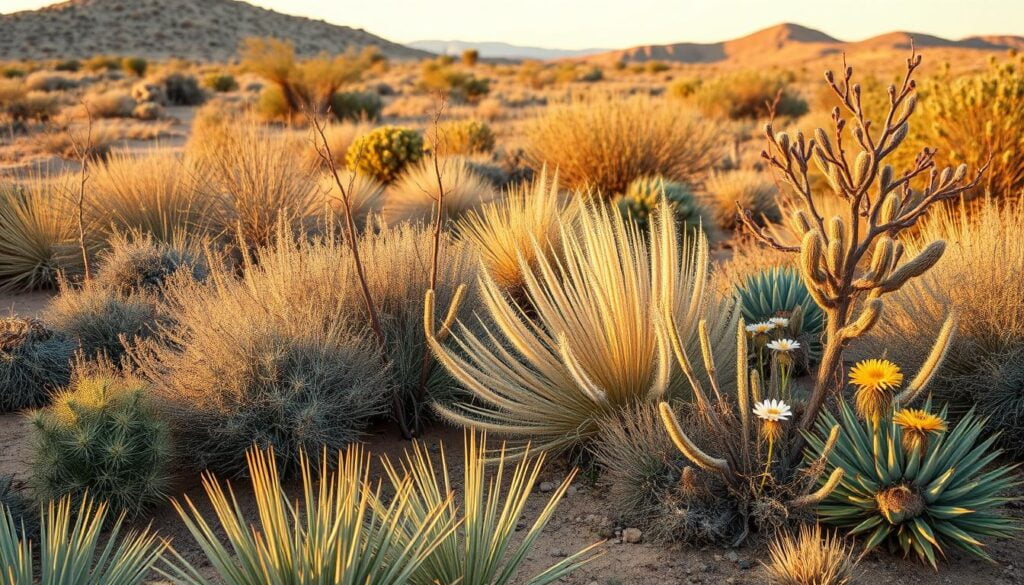
“Shrubs and grasses are the unsung heroes of the desert, their deep roots and resilience serving as the foundation for the entire ecosystem.”
Wildflowers: Bursts of Color in the Desert
The desert landscape changes into a vibrant tapestry when desert wildflowers bloom. These tough plants grow well in dry conditions, showing off their beautiful colors against the desert’s rough backdrop. From the prickly pear cactus to the famous Joshua tree, the desert is full of plants that can survive without much water.
The spring flowering season in the Arizona Upland subdivision goes from mid-February to mid-June, peaking from mid-March to late April. During this time, winter annuals like poppies and lupines create huge colorful displays in the Sonoran and Mohave deserts about once every ten years. Good shows happen in certain areas every three or four years.
Herbaceous perennials and small shrubs bloom in about half the years, peaking in March. Cacti bloom well almost every year, with the most spring-blooming species seen in April. Trees and big shrubs like the creosote bush and whitethorn acacia bloom mainly in spring and sometimes in summer too.
The famous carpets of colorful desert wildflowers appear in the area about once every three or four years, with more reliability in the middle half of April. Summer annuals, like summer poppy and devil’s claw, bloom a few weeks after the first summer rain and can create beautiful displays when it rains a lot.
The bloom of desert wildflowers like California poppies is short-lived, but these plants spend most of their lives as dormant seeds. They wait for the right mix of rain, sun, and wind to grow, sometimes taking years or even decades to bloom.
The bright colors of the prickly pear cactus and the strong shapes of the Joshua tree make a beautiful contrast, showing how desert plants adapt to dry conditions. These bursts of color in the desert show nature’s strength and the amazing variety of plants that live in tough places.
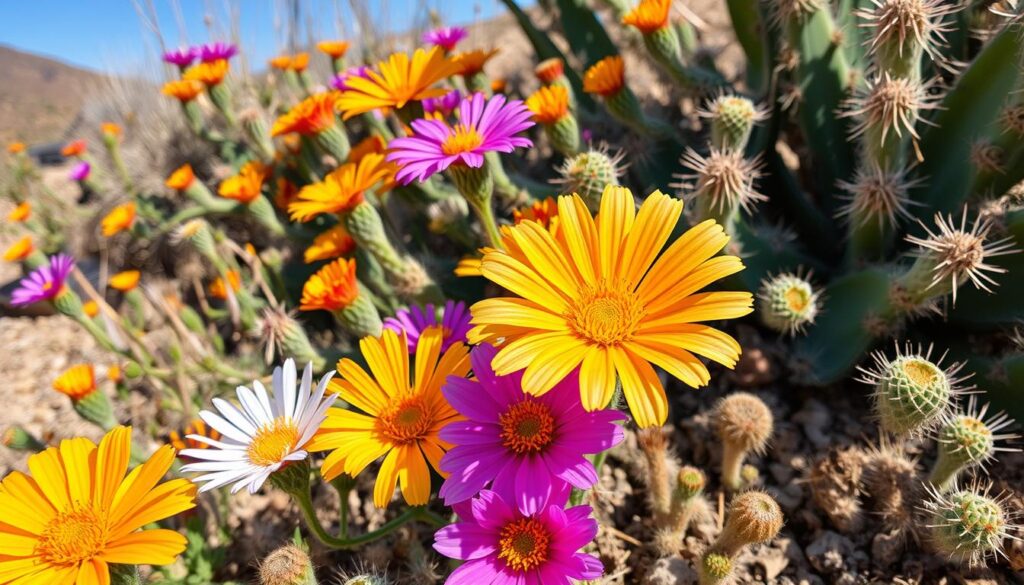
Plants Thriving in Arid Landscapes
The Joshua tree and the organ pipe cactus show how nature can adapt. These desert plants have special ways to survive in dry lands. They are a sign of nature’s cleverness.
Defying the Odds in the Desert
The Joshua tree stands tall in the Mojave Desert, thanks to its deep roots and special adaptation. The organ pipe cactus has many branches and beautiful flowers that bloom at night. It can survive in the hot sun with little water.
Many desert plants have unique ways to survive. The agave has thick leaves to store water. The prickly pear cactus has leaves that don’t lose much water. Each plant has its own way to make the most of the desert’s tough conditions.
| Plant | Adaptation | Native Region |
|---|---|---|
| Agave | Succulent leaves to store water | Southwestern U.S. and Mexico |
| Aloe | Thick, fleshy leaves to conserve moisture | Africa and the Middle East |
| Prickly Pear Cactus | Waxy coating and reduced leaf surface area to minimize water loss | Southwestern U.S. and Mexico |
These desert plants show how nature can adapt and endure. They paint a picture of beauty and strength in tough places.
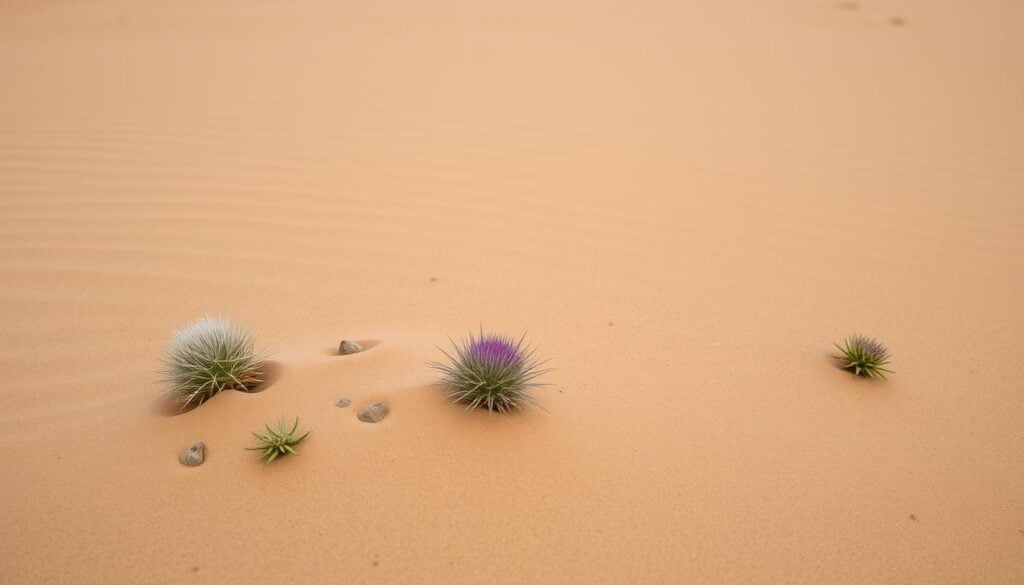
“The desert is a place of beauty and resilience, where nature’s most extraordinary creations thrive in the face of adversity.”
Joshua Tree: Towering Sentry of the Mojave
In the harsh Mojave Desert, the Joshua tree stands out. It’s a symbol of plant life’s strength. These trees, named after Joshua, can grow up to 40 feet high. They thrive in conditions that seem impossible for plants.
Their deep roots help them find water underground. Joshua trees have unique shapes and white flowers. They are made for the Mojave’s full sun and extreme temperatures.
The Joshua tree and the yucca moth have a special bond. This small moth is the only one that pollinates the Joshua tree. After a fire, the moth helps spread the seeds, letting Joshua trees grow back.
“The Joshua tree has endured, its strange, twisted forms silhouetted against the sky, for all the world like some great, petrified monster.”
– Mary Austin, American writer and conservationist
The Joshua tree is now at risk due to urbanization and climate change. Local efforts to save these trees are vital. For example, a Lancaster ordinance helps protect desert plants.
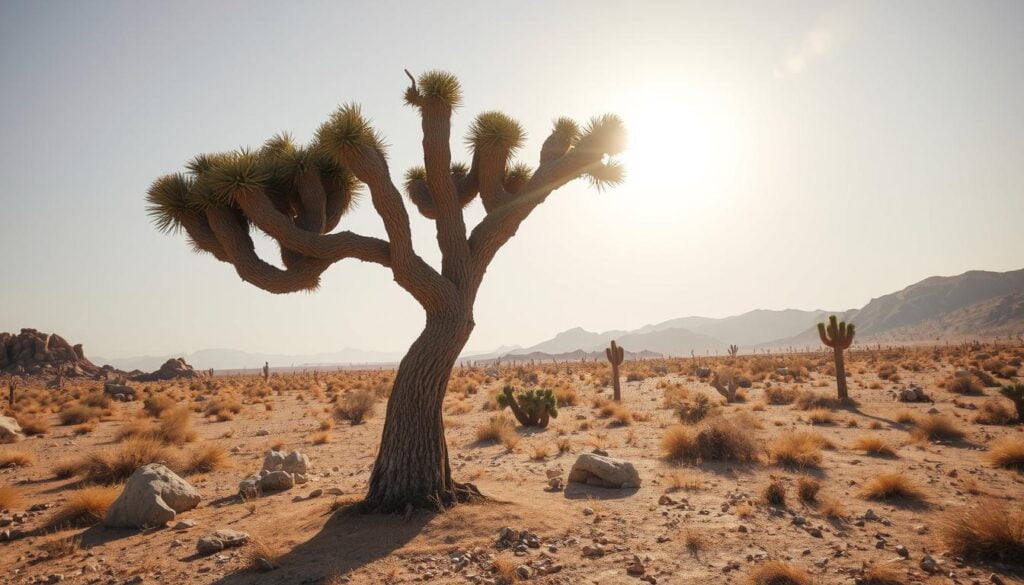
Organ Pipe Cactus: Nighttime Beauty of the Sonoran
In the Sonoran Desert, the Organ Pipe Cactus is a true wonder. It can grow up to 23 feet high, with branches that make it look like a sculpture. This plant lives for hundreds of years, growing slowly but surely.
This cactus thrives in the desert’s harsh sun and dryness. At night, it shows off beautiful light pink or purple flowers. This makes the desert come alive with color.
From May to June, the Organ Pipe Cactus blooms. Its flowers and red fruits are a sight to see. They attract animals and are even edible. This cactus shows how desert plants can be both tough and beautiful.
| Interesting Facts About the Organ Pipe Cactus |
|---|
| – Organ Pipe Cactus National Monument is the only place in the United States to see large stands of organ pipe cacti growing naturally. |
| – The organ pipe cactus originated in the warm, dry tropics and arrived in the Sonoran Desert only about 3500 years ago. |
| – The Organ Pipe Cactus can live to over 150 years in age and produces its first flower near the age of 35. |
| – The greatest growth of the Organ Pipe Cactus occurs during the summer monsoons, growing about 2.5 inches a year. |
| – Cristate cacti, with unusual crowns, are estimated to occur in approximately one in 200,000 cacti. |
The Organ Pipe Cactus shows how desert plants can thrive. Its night flowers and red fruits are amazing. They remind us of the beauty in tough places.
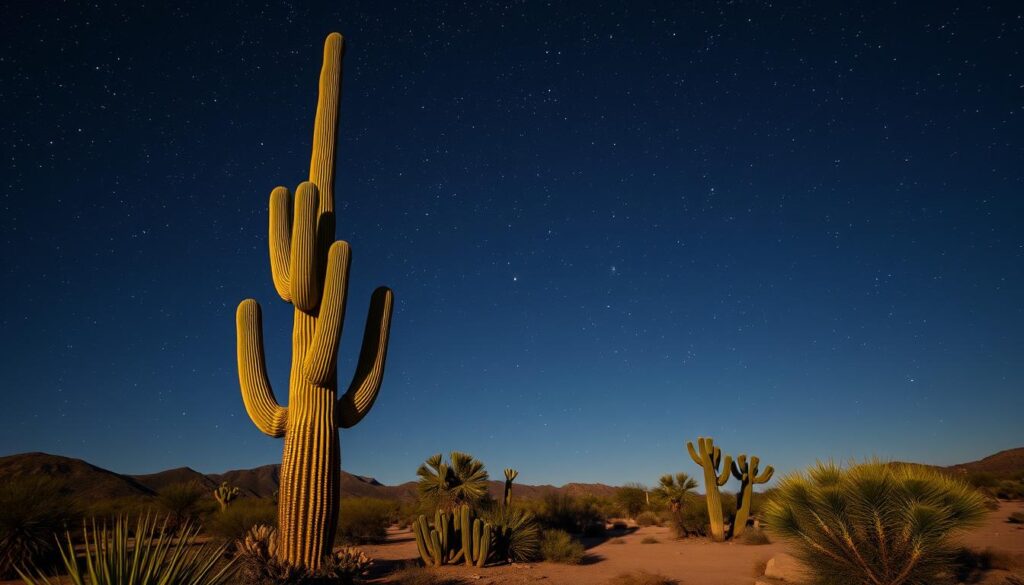
Creosote Bush: Pungent Perseverance
The creosote bush is a desert shrub that shows nature’s strength. It grows in eastern California, Texas, and northern Mexico. This plant has adapted to the desert’s tough conditions with great resilience.
This bush is known for its strong smell, like earthy rain on hot pavement. This smell helps it survive in the desert.
When spring comes, the creosote bush comes alive with bright yellow flowers and small, green leaves. Its deep roots let it find water deep underground, which other plants can’t do.
The creosote bush blooms strongly in the desert, showing its power of adaptation. It can handle extreme heat and little rain, proving its resilience.
| Creosote Bush Facts | Values |
|---|---|
| Used to Treat Human Maladies | Over 40 conditions, from acne to venereal disease |
| Prominence in Papago Tribe’s Creation Myth | Creosote features prominently |
| Radiocarbon Dating of Clones | 9,000 to 11,000 years old |
| Volatile Hydrocarbon Oils Produced | 49 |
| Antioxidant NDGA in Leaves | 5 to 10 percent of dry weight |
| NDGA Antiviral Activity | Against HIV, herpes simplex, and human papilloma viruses |
| FDA Ban on NDGA as Food Preservative | Due to toxicity concerns in 1970 |
| Post-Nuclear Explosion Survival Rate | 20 out of 21 original creosote shrubs re-sprouted |
The creosote bush shows how plants can adapt and survive in tough places. Its strong smell, bright flowers, and deep roots make it a symbol of the desert’s strength.
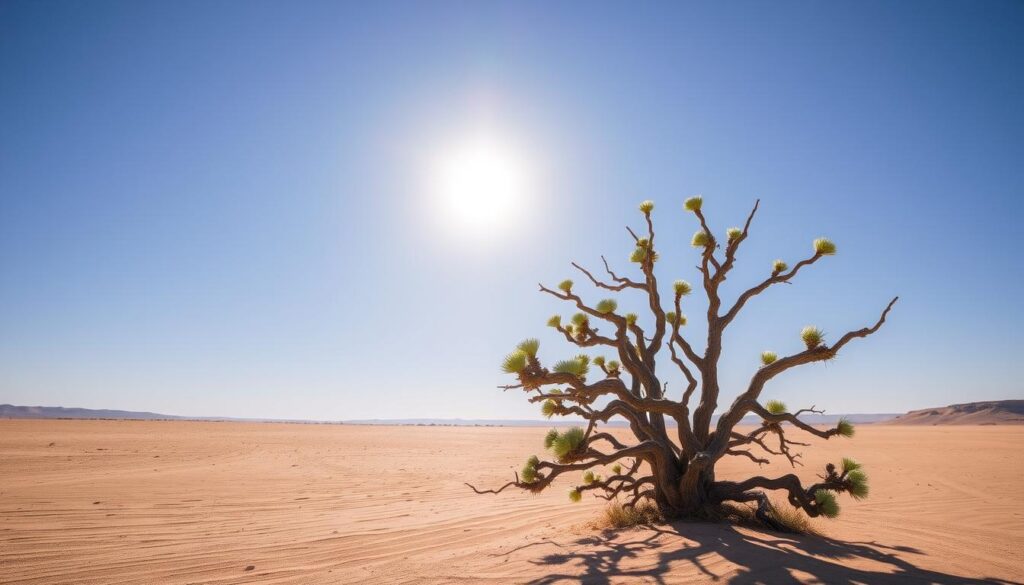
Prickly Pear Cactus: A Colorful Feast for the Eyes
In the Sonoran Desert, the prickly pear cactus is a sight to behold. Its thick, fleshy pads are covered in bright flowers. This plant shows how life can flourish in tough conditions.
The prickly pear cactus belongs to the Opuntia genus. This group of cacti has adapted to survive in dry places. They store water in their pads to make it through the desert’s dry spells.
When the time is right, the cactus bursts into bloom with colors like deep purple, fiery red, and sunny yellow. These flowers brighten up the desert and feed bees and hummingbirds.
Humans can also enjoy the prickly pear cactus. Its fruit, called “tuna,” can be eaten raw or made into jams, jellies, sorbets, and liqueurs. The pads, or “nopales,” are also good to eat and can be used in many dishes.
| Characteristic | Description |
|---|---|
| Size | The prickly pear cactus can grow to a height of 16-23 feet, towering over the desert landscape. |
| Appearance | The plant’s thick, spiny pads resemble the ears of a rabbit, giving it a distinctive and easily recognizable silhouette. |
| Adaptations | The cactus’s ability to store water in its pads allows it to thrive in the arid conditions of the Sonoran Desert. |
| Ecological Importance | The prickly pear cactus serves as a vital food source and habitat for a variety of desert-dwelling wildlife, including birds, bats, and small mammals. |
The prickly pear cactus is a symbol of resilience and adaptability. It shows the amazing diversity and creativity of desert plants. Whether you admire its flowers or taste its unique flavors, it’s a feast for the senses. It gives us a peek into the wonders of the Sonoran Desert.
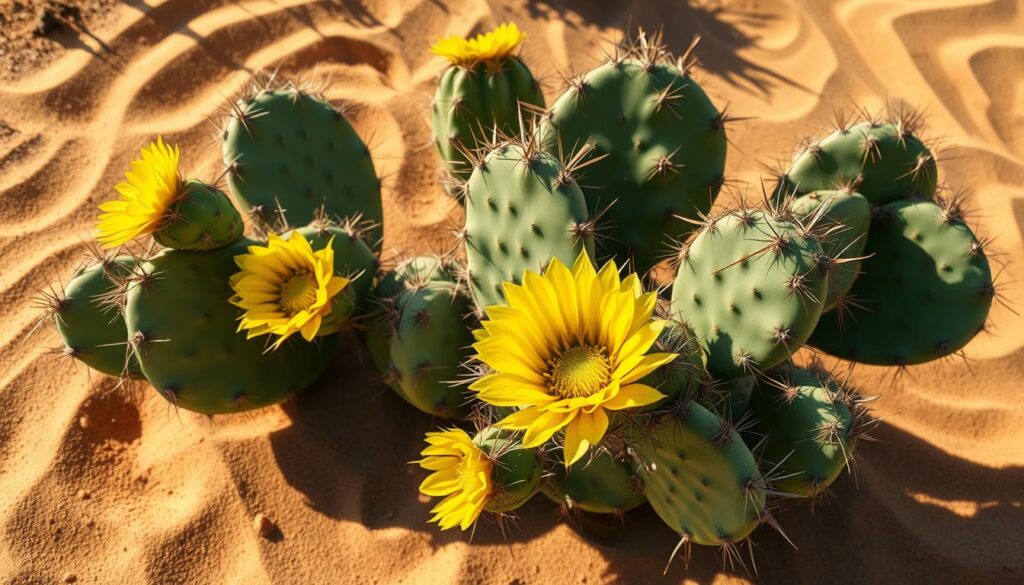
“The prickly pear cactus is a true icon of the Sonoran Desert, a living embodiment of the resilience and beauty that can thrive in the harshest of environments.”
Conclusion
Exploring desert plants has left me amazed by their amazing adaptability. From the iconic saguaros to the tough succulents, they’ve developed smart ways to survive in tough places. Their unique shapes, ability to hold water, and avoiding sleep during dry times show how they beat the odds.
The Joshua Tree and the Organ Pipe Cactus stand out to me. They show how tough and vibrant life can be in harsh lands. These plants prove nature’s strength and how life can adapt to extreme conditions.
Thinking back on my desert journey, I’ve gained a big respect for desert plants. Their story is one of survival and never giving up. It shows how life can adapt, evolve, and get through tough times.
FAQ
What are the unique characteristics of desert plants that enable their survival in harsh conditions?
How do succulents survive in the desert?
What strategies do cacti employ to endure the desert climate?
How do desert shrubs and grasses adapt to the arid conditions?
What role do desert wildflowers play in the ecosystem?
Can you describe some of the most iconic desert plants and their remarkable adaptations?
Source Links
- https://8billiontrees.com/trees/desert-plants/
- https://www.shrubhub.com/blog/20-desert-plants-that-can-withstand-scorching-heat-extreme-drought.php
- https://www.planetnatural.com/desert-plants/
- https://www.epicgardening.com/tough-desert-plants/
- https://planetdesert.com/blogs/news/desert-plant-for-landscaping-design-care-guide?srsltid=AfmBOor–8uoZwOd2w2_jaa0yZPZ2Exfus1dL44Nl9QAWt7TGHGQ8Aan
- https://www.nps.gov/teachers/classrooms/plant-adaptations.htm
- https://www.desertmuseum.org/programs/succulents_adaptation.php
- https://artisanplants.com/blogs/news/plump-perfection-unveiling-the-secrets-of-succulent-water-storage
- https://www.ncbi.nlm.nih.gov/pmc/articles/PMC9015807/
- https://academic.oup.com/jxb/article/68/9/2121/3084721
- https://news.mongabay.com/2023/10/battling-desertification-bringing-soil-back-to-life-in-semiarid-spain/
- https://cp.copernicus.org/articles/14/1915/2018/
- https://www.nbcnews.com/id/wbna48592604
- https://www.frontiersin.org/journals/plant-science/articles/10.3389/fpls.2017.01971/full
- https://www.ncbi.nlm.nih.gov/pmc/articles/PMC6018961/
- https://www.gardendesign.com/desert/plants.html
- https://dbg.org/top-ten-desert-plants-for-your-garden/
- https://ucmp.berkeley.edu/exhibits/biomes/deserts.php
- https://greg.app/succulent-benefits/
- https://home.howstuffworks.com/succulents-go-without-water.htm
- https://ethnobiology.org/forage/blog/5-interesting-survival-plants-some-history
- https://www.survivalfrog.com/blogs/survival/tactical-landscaping-prickly-plants-that-defend-your-yard-against-intruders?srsltid=AfmBOopjVfAd2Pv-N–A2eERr9mQBo-ZCwv4ovYSn-6nWY9mxWzF2TCn
- https://www.cbr.com/rdr-survivalist-challenge-complete-guide-walkthrough/
- https://prairieecologist.com/2019/09/17/a-deep-rooted-prairie-myth/
- https://www.resilience.org/stories/2023-12-12/welcoming-the-weeds-farming-like-an-ecosystem-part-2/
- https://www.theguardian.com/lifeandstyle/article/2024/may/03/10-shrubs-that-will-thrive-in-your-garden
- https://www.desertmuseum.org/programs/flw_flowering.php
- https://www.hcn.org/articles/photos-superbloom-in-california/
- https://harvesttotable.com/25-plants-for-arid-and-desert-gardens/
- https://www.epicgardening.com/drought-tolerant-plants/
- https://www.provenwinners.com/learn/top-ten-lists/10-perennials-and-shrubs-hot-dry-climates
- https://thetrek.co/pacific-crest-trail/on-challenge-reaching-new-heights-at-the-summit-of-mt-san-jacinto/
- https://www.latimes.com/archives/la-xpm-1988-01-03-mn-32476-story.html
- http://mojavedesertarchives.blogspot.com/2016/
- https://www.nps.gov/orpi/learn/nature/organ-pipe-cactus.htm
- https://airstreamtravelers.wordpress.com/2017/03/02/organ-pipe-cactus-natl-monument-a-rare-beauty-is-found/
- https://theazhikeaholics.com/organ-pipe/
- https://www.marfapublicradio.org/show/nature-notes/2013-04-17/creosote-medicine-2
- https://extension.usu.edu/forestry/files/publications/other-publications/desert-plants-of-utah.pdf
- https://greg.app/sunburst-prickly-pear-cactus-benefits/
- https://bybio.wordpress.com/tag/prickly-pear-cactus/
- https://www.rseco.org/content/126 -conclusion-and-references.html
- https://grownextgen.org/download/student-research/the-effect-of-soil-on-plant-growth/sciencefairconclusionorzechowski.pdf
